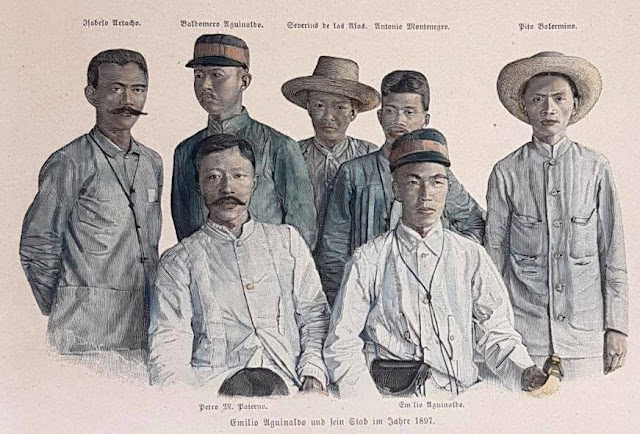The Aguinaldo Collar
For his inauguration in 1981, President Ferdinand Marcos Sr. donned a Barong Tagalog that not only reimagined the "national dress" but also set the barong fashion trend for the 1980s. Commonly referred to as the "Chinese collar" barong, this portrayal was swiftly refuted and corrected by the designer. He clarified that the inspiration was drawn directly from the uniforms worn by Filipino revolutionaries. To substantiate this claim, an image was presented, depicting Aguinaldo and his compatriots alongside Pedro Paterno. This photograph likely captured the concluding stages of the Biak-na-Bato negotiation, highlighting the distinctive rayadillo fabric and the presence of short standing collars. Despite the distinctiveness of this new look and the notable influence of Aguinaldo's (and his officers) uniform with its defined collar on contemporary fashion, discussions on this evolution and its connection to Aguinaldo's contribution remain limited, with insufficient studies and commentaries. Consequently, this topic has largely faded from memory.
Upon reflection, it strikes me that throughout history, there has been a subconscious tendency to marginalize elements associated with Aguinaldo. It's possible that his longevity inadvertently led to his neglect, as his extended lifespan appeared to contribute to his diminishing influence. While considering the names of streets across the nation, one can observe popular choices like "M.H. del Pilar," "J.P. Rizal," or "A. Mabini." In comparison, "E. Aguinaldo" appears less frequently.
In recent times, there has even been an effort to designate Andres Bonifacio, the Supremo, as the First President. This reevaluation further underscores the relegation of Aguinaldo, who is depicted as a secondary figure. Luneta Park remains sacred ground dedicated to Rizal, with December 30th marked by marches and speeches in his honor. Liwasang Bonifacio serves as the venue for expressing national grievances, commonly referred to as "magsumbong ang Bayan" (the nation's grievances). The red-themed celebration on November 30th, commemorating Bonifacio, further highlights his significance. This prompts the question: Where does Emilio Aguinaldo fit in? Do we have an Aguinaldo Day?
During flag ceremonies held in schools and other locations across the country, I often ponder the extent to which young students are unaware that the anthem they sing and the flag they raise owe their existence primarily to the efforts of a man who seems to have been conveniently forgotten by the nation.
Upon reflection, it strikes me that throughout history, there has been a subconscious tendency to marginalize elements associated with Aguinaldo. It's possible that his longevity inadvertently led to his neglect, as his extended lifespan appeared to contribute to his diminishing influence. While considering the names of streets across the nation, one can observe popular choices like "M.H. del Pilar," "J.P. Rizal," or "A. Mabini." In comparison, "E. Aguinaldo" appears less frequently.
In recent times, there has even been an effort to designate Andres Bonifacio, the Supremo, as the First President. This reevaluation further underscores the relegation of Aguinaldo, who is depicted as a secondary figure. Luneta Park remains sacred ground dedicated to Rizal, with December 30th marked by marches and speeches in his honor. Liwasang Bonifacio serves as the venue for expressing national grievances, commonly referred to as "magsumbong ang Bayan" (the nation's grievances). The red-themed celebration on November 30th, commemorating Bonifacio, further highlights his significance. This prompts the question: Where does Emilio Aguinaldo fit in? Do we have an Aguinaldo Day?
During flag ceremonies held in schools and other locations across the country, I often ponder the extent to which young students are unaware that the anthem they sing and the flag they raise owe their existence primarily to the efforts of a man who seems to have been conveniently forgotten by the nation.
Postscript
My Last Words On the Barong Tagalog
In the mid-1990s, if my memory serves me correctly, during the APEC Summit, a local journalist penned an article discussing the possible origins of the Barong Tagalog. This journalist provided reasons behind the use of translucent fabric for the barong and the tradition of wearing it untucked. In the article, there was an implication that the Spanish colonizers had compelled Filipinos to wear these semi-transparent garments as a means of detecting concealed weapons hidden beneath the shirt. The journalist went so far as to insinuate that the barong was a symbol of subjugation, portraying it as a humble attire of the colonized. Interestingly, this perspective gained traction when it was picked up by Thai media and subsequently circulated on the internet, the rest was unverified History.
Wear your barong proudly. That journalist got it all wrong!
 |
| "El Mestiso" by Justiniano Asuncion from his Tipos del País (19th Century Watercolor). Look at that barong! |
%20(3).jpg) |
| Andres Bonifacio Monument-- Now that's how you wear a barong when you go to a revolution. |



.png)


Comments
Post a Comment